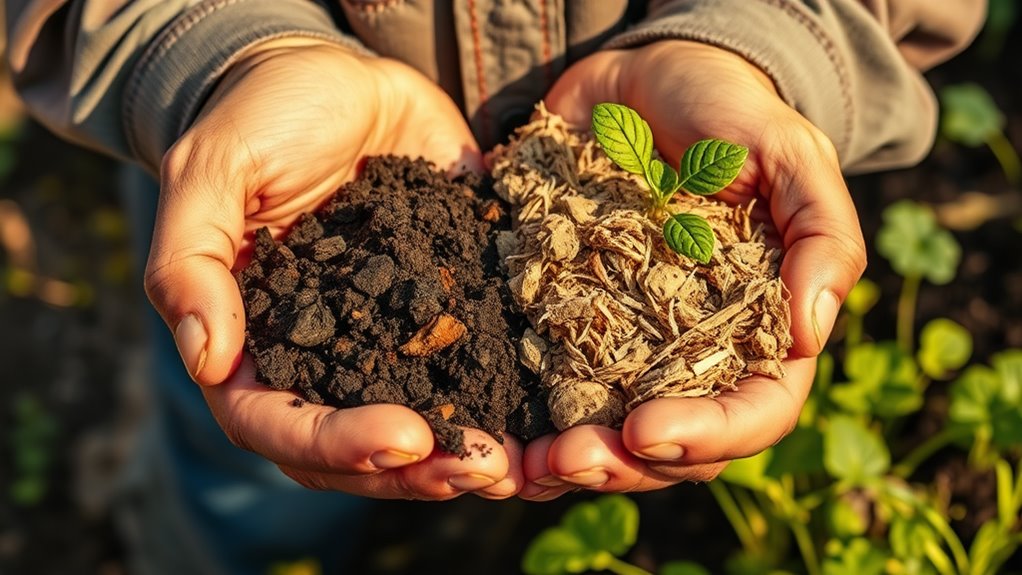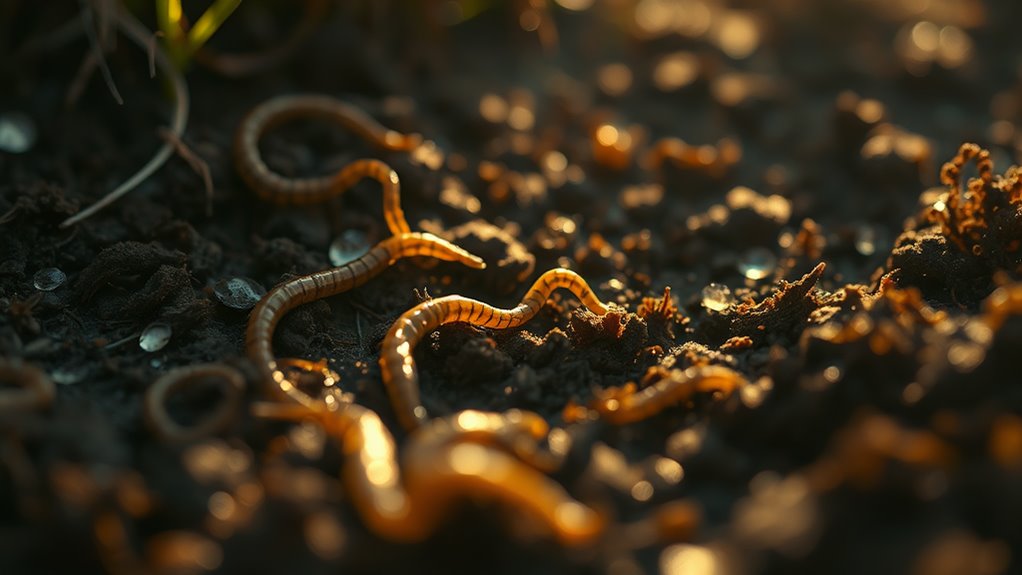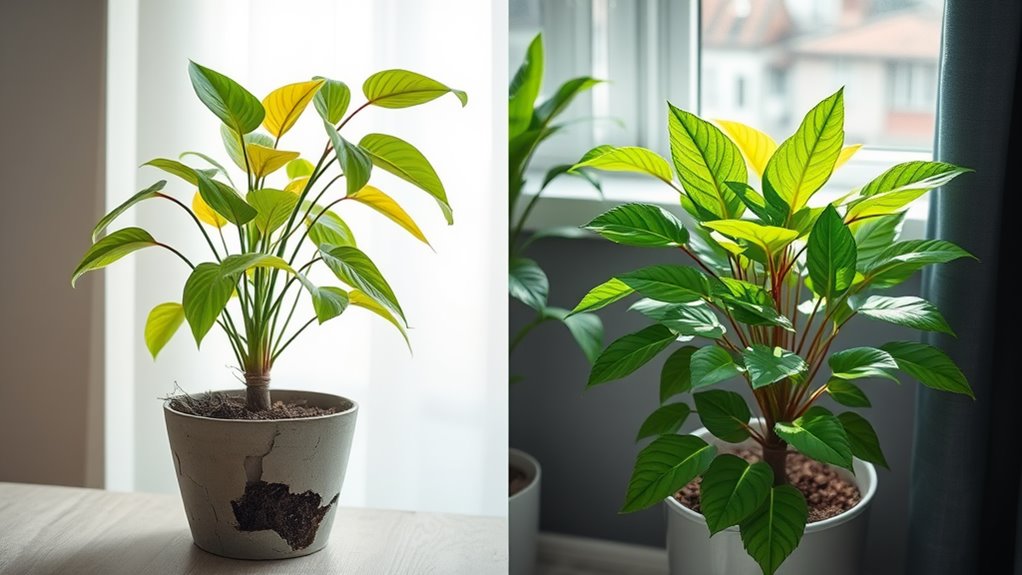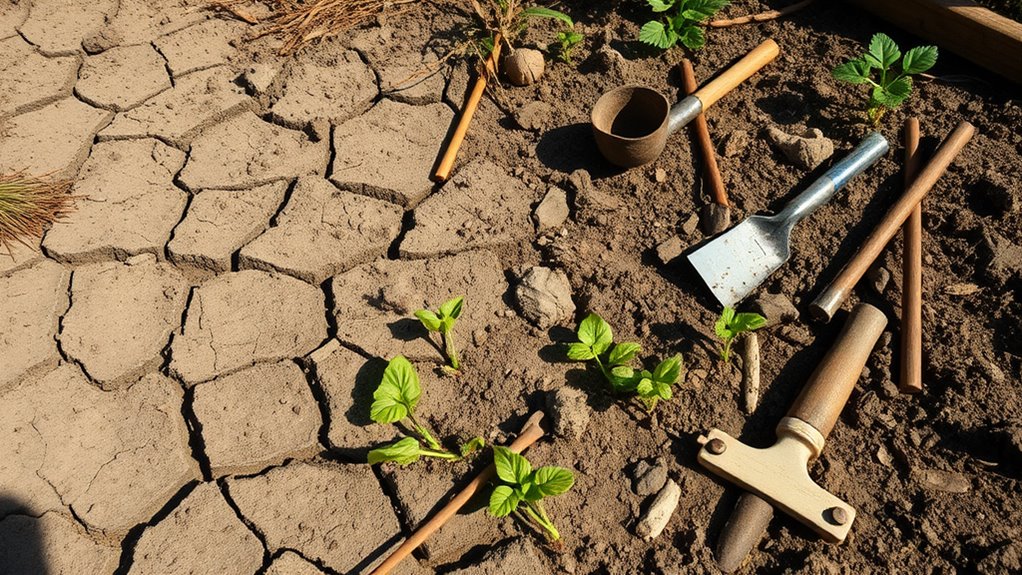Why I Never Plant Without Testing My Soil First
You’ll ensure your garden thrives by testing soil first, accurately assessing pH and key nutrients like nitrogen, phosphorus, and potassium to prevent deficiencies and imbalances. This targeted approach lets you apply amendments precisely, boosting plant growth, improving structure, and avoiding costly mistakes like over-fertilizing. By optimizing conditions, you’ll maximize yields and build sustainability, so keep exploring these practical tips for even better results.
Key Takeaways
- Soil testing provides an accurate assessment of pH and nutrients, preventing costly planting mistakes.
- It detects nutrient deficiencies early, ensuring healthy plant growth and avoiding stress.
- Testing allows tailored soil preparation, optimizing nutrient availability for better yields.
- It identifies hidden issues like compaction or salinity, building a sustainable garden foundation.
- Regular testing saves money by targeting amendments precisely and monitoring soil health over time.
The Benefits of Knowing Your Soil’s Nutrient Levels
When you test your soil’s nutrient levels, you’ll gain precise insights that directly enhance your planting outcomes.
Soil testing benefits include accurate assessment of pH and essential nutrients like nitrogen, phosphorus, and potassium, enabling tailored fertilization for optimal plant development.
You’ll maximize nutrient uptake, fostering robust root systems and vigorous growth while minimizing resource waste. Additionally, soil testing can prevent costly gardening mistakes by identifying issues early and avoiding unnecessary expenses.
This scientific method supports efficient water management and balanced soil composition, leading to increased yields and cost savings.
Moreover, by incorporating soil testing into your routine, you can unlock garden success and ensure long-term garden health.
How Soil Testing Prevents Nutrient Deficiencies
Soil testing empowers you to detect nutrient deficiencies early, ensuring your plants thrive without setbacks.
By analyzing soil samples for key elements like nitrogen, phosphorus, and potassium, you’ll identify shortages before they stunt growth or reduce yields.
For instance, if tests reveal low phosphorus, you can apply targeted fertilizers to boost root development and flowering.
This proactive approach minimizes plant stress, prevents issues like yellowing leaves or poor fruiting, and optimizes resource use.
You’ll save time and money by amending soil precisely, fostering healthier, more productive gardens through data-driven decisions.
Identifying and Correcting Soil Ph Imbalances
You test your soil’s pH using a reliable kit or lab analysis to determine if it’s too acidic or alkaline for your plants.
If the pH isn’t in the optimal range, you’ll add amendments like lime to raise it or sulfur to lower it, based on your test results. To further enhance your soil naturally, consider utilizing backyard solutions with materials readily available in your garden.
This precise adjustment ensures your soil supports healthy nutrient uptake and plant growth.
By prioritizing this process, you can help debunk common myths about soil and promote accurate soil knowledge for improved gardening practices.
Testing Soil Ph
One essential step in soil preparation involves testing its pH to detect imbalances that affect nutrient availability. You’ll use reliable methods like soil test kits or professional labs to measure pH accurately, ensuring you identify acidic, neutral, or alkaline conditions. This process reveals how pH influences nutrient uptake, guiding your planting decisions.
| pH Range | Soil Condition | Key Implication |
|---|---|---|
| 4.0-5.0 | Very Acidic | Limits phosphorus availability |
| 5.1-6.5 | Moderately Acidic | Enhances micronutrient access |
| 6.6-7.3 | Neutral | Optimal for most nutrients |
| 7.4-8.0 | Alkaline | Reduces iron and manganese uptake |
Adjusting Ph Levels
After identifying soil pH imbalances through testing, you’ll need to correct them promptly to optimize nutrient uptake.
For acidic soil (pH below 6), apply agricultural lime—such as calcitic or dolomitic—at rates your test recommends, typically 2-5 pounds per 100 square feet, and incorporate it by tilling deeply.
To lower alkaline soil pH (above 7), add elemental sulfur or aluminum sulfate, using about 1-2 pounds per 100 square feet, then water well for even distribution.
Always mix amendments thoroughly, retest after 6-8 weeks, and adjust gradually to prevent nutrient imbalances, ensuring ideal conditions for plant health.
Enhancing Plant Growth Through Proper Soil Preparation
Proper soil preparation significantly enhances plant growth by optimizing nutrient availability and soil structure. Avoiding soil prep mistakes is essential to ensure long-term garden success.
As you amend your soil, you’ll boost fertility through organic additions, ensuring roots access water and air efficiently for stronger development. This practical approach fosters healthier plants by improving texture and preventing common issues like poor drainage.
- Add compost to enrich organic matter and stimulate microbial activity.
- Aerate the soil to reduce compaction and enhance root penetration.
- Incorporate perlite for better drainage in heavy soils.
- Mix balanced organic fertilizers based on test results.
- Apply mulch to regulate moisture and maintain stable soil temperature.
Adopting universal soil prep methods ensures these techniques can be tailored to various environmental conditions for optimal results.
Avoiding Costly Mistakes in Your Garden
You test soil quality to pinpoint nutrient deficiencies or pH imbalances that could undermine your garden’s success.
By acting on these findings, you prevent plant loss from avoidable issues like poor drainage or toxicity.
This approach lets you cut garden costs through targeted amendments rather than wasteful overhauls.
By decoding soil signs, you can better interpret indicators of soil health for improved garden management.
Moreover, adopting natural soil preparation can enhance your harvest while promoting healthier plants and increased yield without relying on fertilizers.
Test Soil Quality
Although overlooking soil quality can lead to disappointing yields, testing it first helps you pinpoint issues like pH imbalances or nutrient deficiencies, preventing costly garden failures.
By conducting a thorough soil test, you’ll gain precise data to optimize your garden’s foundation.
-
Collect samples accurately: Use a clean trowel to gather soil from multiple spots at 6-8 inches depth, mixing them for a representative sample.
-
Choose reliable tests: Opt for lab kits that measure pH, nitrogen, phosphorus, and potassium levels with scientific accuracy.
-
Interpret results practically: Compare findings against plant-specific requirements to identify imbalances quickly.
-
Apply amendments wisely: Based on tests, add lime for acidic soil or organic matter for poor nutrients.
-
Track changes over time: Retest annually to monitor improvements and maintain soil health effectively.
Prevent Plant Loss
By addressing common pitfalls early, you’ll safeguard your plants against loss and costly setbacks in your garden.
Soil testing reveals nutrient deficiencies, such as low nitrogen or phosphorus, which can stunt growth and lead to plant death if unaddressed. It also identifies pH imbalances that block nutrient absorption, allowing you to amend soil precisely with lime or sulfur.
Cut Garden Costs
Minimizing garden costs starts with pinpointing avoidable mistakes that inflate expenses and undermine efficiency.
By testing your soil first, you’ll prevent overspending on fertilizers, water, and plants that don’t suit your conditions, ensuring smarter, sustainable choices for better yields.
-
Test pH and nutrients: You’ll avoid nutrient imbalances that waste fertilizers and harm plants.
-
Assess soil texture: This helps you select drought-resistant varieties, cutting irrigation costs.
-
Check drainage: Prevent waterlogging to reduce root rot and replanting expenses.
-
Identify contaminants: Early detection stops toxic buildup, saving on remediation.
-
Monitor organic matter****: Optimize compost use to boost fertility without excess spending.
Increasing Yields With Optimized Soil Conditions
To optimize your soil conditions, you’ll enhance crop yields by ensuring nutrients, pH levels, and moisture balance suit your plants’ needs.
Start by analyzing soil test results to adjust nitrogen, phosphorus, and potassium levels—applying targeted fertilizers boosts root development and fruit production.
Fine-tune pH to 6.0-7.0 for most crops, unlocking nutrient availability and reducing deficiencies.
Manage moisture through mulching or irrigation, preventing drought stress and root rot for consistent growth. Additionally, incorporate organic composting using kitchen scraps and garden waste to recycle nutrients and further enrich your soil naturally.
Scientifically, these practices minimize waste, maximize photosynthesis, and increase harvest by 20-50%, making your gardening efforts more efficient and productive.
Moreover, by adopting sustainable practices like natural fertilizing methods, you can foster a thriving garden ecosystem while reducing reliance on synthetic options.
Detecting Hidden Soil Problems Before Planting
Before planting, you must identify hidden soil problems like compaction, salinity, or pathogens that can sabotage crop health and yields.
You’ll use targeted tests to reveal these issues early, preventing damage and ensuring productive soil. Conduct assessments systematically for precise results.
-
Use a penetrometer to measure soil compaction, identifying areas where roots can’t penetrate.
-
Test electrical conductivity to detect salinity levels that hinder nutrient uptake.
-
Sample soil for pathogen screening via lab cultures, spotting diseases before they spread.
-
Analyze soil texture to uncover poor structure affecting water movement.
-
Monitor organic matter content to reveal imbalances that exacerbate hidden problems.
Building a Sustainable Garden Foundation
You’ve identified hidden soil problems, so you now create a sustainable garden foundation by improving soil health and structure. For instance, transform kitchen scraps into valuable compost to further enhance nutrient availability and support a thriving ecosystem.
Incorporate compost to increase organic matter, fostering beneficial microbes that enhance nutrient cycling and water retention.
Aerate compacted soil using a fork to promote root growth and drainage.
Adjust pH precisely with lime for acidic conditions or sulfur for alkaline ones, based on test results.
Add cover crops like legumes to fix nitrogen and prevent erosion.
Monitor improvements through regular testing, ensuring long-term fertility and resilience in your garden ecosystem.
Additionally, enhance your composting with simple ingredient swaps to achieve richer soil and more efficient decomposition.





